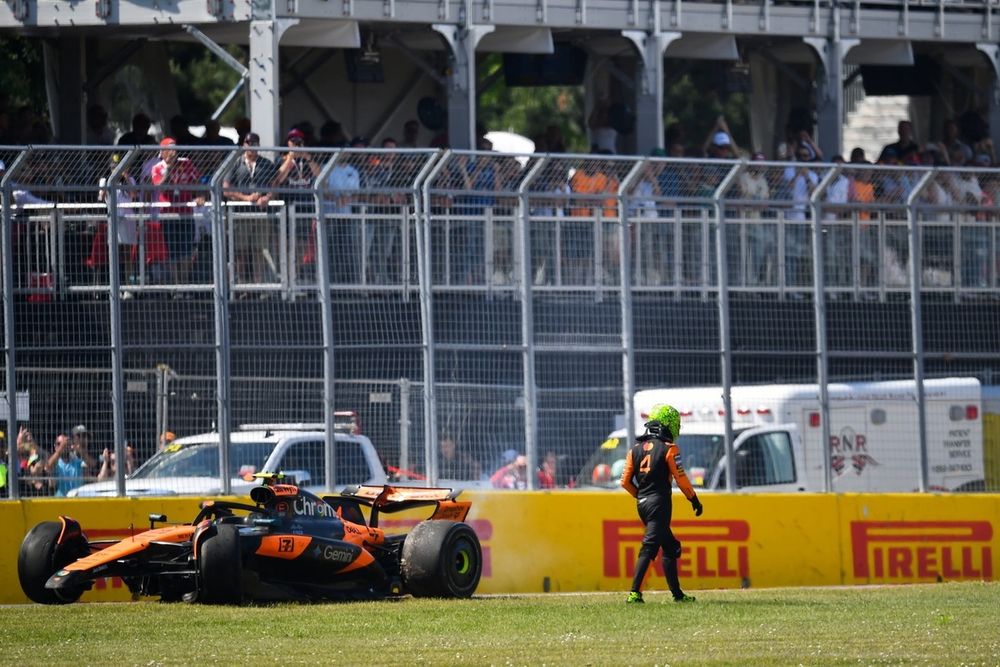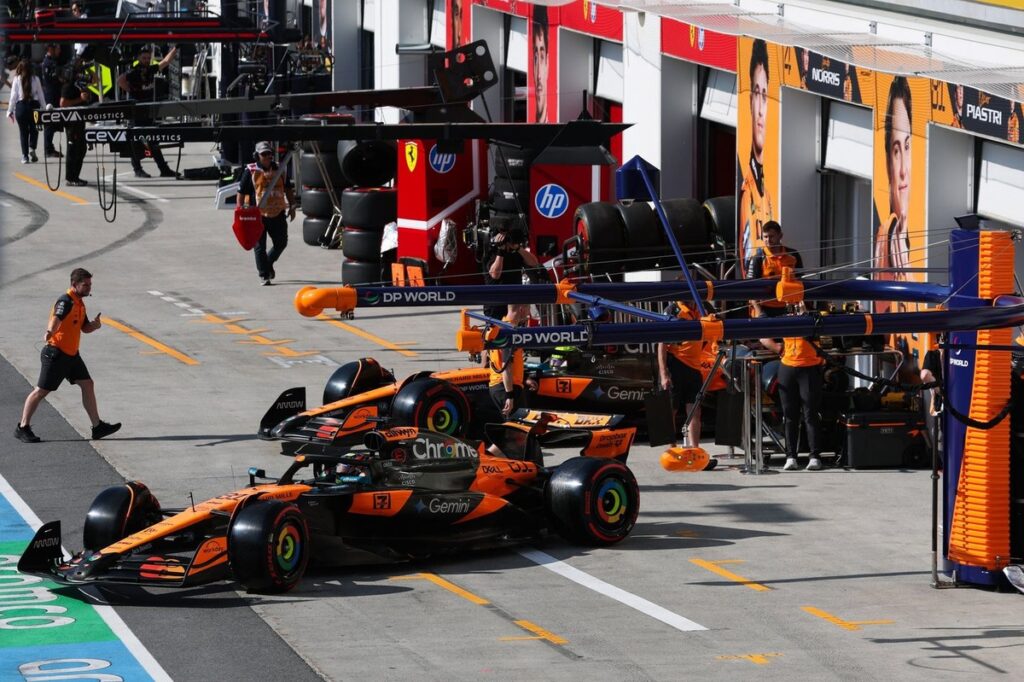When Andrea Stella talked to the Formula 1 press during a technical media session in the Monaco pitlane, the team principal didn’t just chat about the MCL39.
Stella talked about fruits as well…about apples and pears to be precise. According to the McLaren boss, not all tracks on the F1 calendar are comparable – they fall into different categories, just like apples and pears.
When it was suggested that the Imola weekend had been a slight disappointment for McLaren, Stella responded: “I am in disagreement with this statement. I think there’s a tendency to compare apples and pears. When I was at school the teacher always said don’t compare apples and pears. Make sure you are specific, analytical, precise in how you use information.”
“Imola belongs to the category of tracks like Saudi Arabia and Japan; high-speed corners, narrow tracks”, he explained. “But if we compare the race in Imola with the race in Miami, we are comparing an apple with a pear, and my school teacher would grab my ear and say, ‘don’t compare apple and pears’.
“Miami is a low-speed dominated circuit and with all the aerodynamic investment we have done, our car has improved massively in these low-speed corners. If we want to compare Miami, let’s look back at what happened in China and Bahrain.”
Stella didn’t place the Circuit Gilles Villeneuve into either category – and for good reason. The Montreal track isn’t an apple or a pear, meaning a third fruit might be needed to describe it.
Andrea Stella, McLaren
Photo by: James Sutton / Motorsport Images
While Bahrain is all about tyre degradation, and Suzuka and Jeddah are defined by high-speed cornering, Canada is different. On the Ile Notre-Dame, it’s mostly about long straights, heavy braking zones, and tight, slow corners – more often than not in the form of chicanes. That makes it hard to compare with other tracks so far and demands different things from an F1 car.
Two reasons for a more complicated weekend?
The Circuit Gilles Villeneuve is located in a park – Parc Jean-Drapeau – which means it tends to have low grip, especially early in the weekend. Add to that the need to get close to the walls – including the infamous Wall of Champions – to gain lap time, and it’s clear that driver confidence plays a big role. A predictable and relatively ‘easy’ car over one lap helps to build that confidence, but that’s one of the few things McLaren doesn’t have this year.
Although the MCL39 is undeniably the fastest car on the grid, it can be tricky over a single lap, as Stella has explained multiple times.
In many qualifying sessions this season, the drivers – particularly Lando Norris – have struggled to extract the maximum performance out of it. While part of that is down to the drivers, another part is that the MCL39 can be unpredictable when everything is on the limit during a flying lap. It’s particularly crucial at a track like Montreal and it hurt the team last week.
It was noticeable from the very first practice session. Both McLaren drivers frequently went off track, often cutting the final chicane. In FP3, Oscar Piastri hit the Wall of Champions, though he recovered admirably well in qualifying. In the deciding stages of Q3 Norris made a costly mistake and was unable to recover from it. He had to settle for P7. While this might say something about the difference between Norris and Piastri, it also reflects on the characteristics of the McLaren car.
On the flip side, McLaren typically boasts superior race pace and tyre management – especially the rear tyres. But in Montreal, McLaren couldn’t fully leverage that strength.

Lando Norris, McLaren, Oscar Piastri, McLaren
Photo by: James Sutton / Motorsport Images via Getty Images
“I think one of the reasons why this circuit has been a little bit of a struggle is that even if it’s low-speed corners, there’s actually a lot of braking and traction,” Stella said. “There’s not much mid-corner phase in itself. You are either on the brakes or on the throttle. And in both conditions, we have to say that the car struggled a bit to start with.”
In Canada, graining (particularly front-left) became the main issue, whereas McLaren typically shines by extending the life of its rear tyres.
“I think where we came into our own was when everyone else was degrading, we were good. And unfortunately, we probably needed the race to be about 100 laps, not 70, to take advantage of that,” Piastri jokingly put it.
Piastri’s words align with the Friday long runs and the final stint of the race. McLaren was slightly faster than the rest, but not to the extent we’ve seen in most races so far. The race pace of the top three teams (McLaren, Mercedes, and Red Bull – at least Verstappen) was much closer than in previous weekends.
Add to that the fact that overtaking in Montreal is not an easy task – and the clash that Norris caused – and it becomes clear why McLaren couldn’t make much progress in the race after its qualifying issues.
What does this mean for the upcoming race weekends?
Most of the factors mentioned are specific to Canada, meaning McLaren still remains the benchmark and the favourite for grands prix to come. The MCL39 is still the most all-round car on the grid and the tyre advantage hasn’t disappeared overnight; it just didn’t show as strongly in Canada.

Lando Norris, McLaren
Photo by: James Sutton / Motorsport Images via Getty Images
That said, there are three elements to watch out for. The first two are linked: McLaren’s qualifying difficulties are still there, and the new front suspension hasn’t completely solved them.
Stella explained that the upgrade is meant to give drivers more front-end feel – an area Norris has struggled with in particular. It’s no surprise that the Brit stuck with the new specification throughout the weekend, but judging by Q3, it’s not a silver bullet yet. Stella pointed to Norris’s pace in practice and called it a successful experiment, but Piastri opted not to use the new spec after testing it in practice. Whether it becomes a true game-changer remains to be seen, but for now, qualifying remains one of the few areas where rivals can hurt McLaren.
The third factor is those rivals. McLaren clearly remains the frontrunner in F1, but other teams are starting to see glimmers of hope. Mercedes has historically been quick in Montreal, and although the track suits them, the surprisingly high temperatures on Sunday didn’t stop the Silver Arrows from performing well.
Toto Wolff highlighted the new rear suspension as a potential explanation. Since 2022, Mercedes has often thought it’d turned a corner, only to face fresh disappointment at the next race. Caution is warranted, but if the new rear suspension truly is a step forward, then Mercedes could become a factor – at least at specific tracks.
Red Bull also sees some positives from recent races. Verstappen won in Imola and managed to keep his medium tyres alive for longer than Piastri. Christian Horner noted that the pace in Barcelona – up until the chaotic ending of the race – wasn’t bad either, and Verstappen managed to stay ahead of both McLarens in Montreal.
It’s not game-changing just yet and Verstappen admitted that Red Bull still has a lot of work to do if it seriously wants to fight for the title, but there are at least some glimpses of hope for the Milton Keynes-based squad.
McLaren, despite their minor dip in Canada (still including the fastest long runs), remains the strong favourite for races to come, but if the rivals’ recent steps forward prove real – and if McLaren doesn’t fully iron out its few remaining weaknesses – then it might just make things a bit more interesting than, let’s say, Miami or China.
Yes, those could be apples – or maybe even pears – but for the neutral F1 fan, it would at least be good news.
In this article
Ronald Vording
Formula 1
Lando Norris
Oscar Piastri
McLaren
Be the first to know and subscribe for real-time news email updates on these topics
Subscribe to news alerts
Read the full article here

